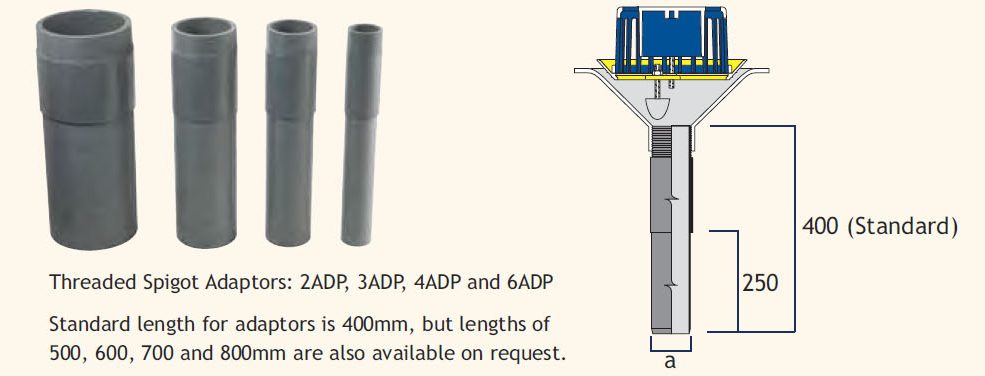
– A brief video – you need to use either PTFE tape or silicone sealant – otherwise it will not be watertight
Threaded Spigot Adaptors (Product Code: 2ADP/3ADP/4ADP/6ADP)
The Threaded Spigot Adaptor (ADP) has been designed to facilitate the connection of Harmer Roof AV and threaded aluminium rainwater outlets to all types of pipe systems.
This method also presents an economic alternative to using a short length of steel gas tube in the case of cast iron socketed or socketless systems.
Threaded Spigot Adaptors in ABS plastic are supplied in 400mm lengths, taper-threaded externally at one end and chamfered at the other end.
Sizes are available to suit 50, 75, 100 and 150mm nominal bore pipework.
Standard length for adaptors is 400mm, but lengths of 500, 600, 700 and 800mm are also available on request.
Connection to Pipework
The Threaded Spigot Adaptor is screwed into the base of the outlet using a PTFE tape or silicone sealant to obtain a gas-tight seal.
The spigot end of the adaptor can then be connected to the pipe socket.
If necessary, the length of the spigot end of the adaptor can be reduced by cutting as required with a fine-toothed saw.
(The spigots of the Threaded Spigot Adaptors are suitable for direct connection to cast iron pipework, HDPE pipework with appropriate Harmer couplings, and PVC O-ring socketed pipe.)
Watch our short demo video:
Fitting the Harmer Threaded Spigot Adaptor
Connecting Adapter – Method 1 – Using PTFE tape:
Thread seal tape (also known as PTFE tape, Teflon tape, or plumber’s tape) is a polytetrafluoroethylene (PTFE) film tape commonly used in plumbing for sealing pipe threads. The tape is sold cut to specific widths and wound on a spool, making it easy to wind around pipe threads. N.B. The thread area on the ADPs is 40mm deep but the common tape widths are 10mm or 12mm.
One key characteristic of PTFE thread seal tape is that it’s water-repellent, which makes it ideal for use in a wide range of plumbing and ductwork applications.
Another of its most prized qualities is that it’s a very low friction material, which is why it’s very often used mainly to lubricate joint threads in piping: a layer of PTFE tape around the threads of a joint can make it much easier to screw more tightly together, and to uncouple the mating parts later on.
I found this video helpful: https://youtu.be/C0kBeMNfWx8?t=114
- Inspect all threads and ensure they are free of dirt, grease and foreign matter.
- Apply sufficient PTFE tape to the taper male threaded end of the adapter. This requires care as too much tape will limit the amount of travel within the parallel thread of the outlet and too little may prevent an effective seal.Hold the roll of tape in over the index finger of your right hand and ADP in your left hand.Lay the start of the tape on top of the thread (Start one thread down from the open end, to prevent any scraps of material sheared off) and, holding it in place with the index finger of your left hand, draw the roll down behind the ADP – applying tape in this direction means the tape will not unwind when you screw the ADP into the Roof Outlet. Finish wrapping (between 2-3 times), one thread back from the end of the ADP.
- Securely tighten the adapter into the outlet, using chains or similar equipment (we’ve used a strap wrench).
Connecting Adapter – Method 2 – Using silicone sealant (DOW CORNING 791 recommended):
- Inspect all threads and ensure they are free of dirt and foreign matter.
- Allow for ventilation and degrease the threads of the outlet using a degreasing agent and fine brush.
- Using paper towels ensure that threads are dry.
- Apply a liberal coating of silicone sealant to the threads of the outlet and adapter and immediately tighten using chains or similar equipment.
- A surplus of sealant will squeeze out indicating that all the thread void areas have filled.
- Clean up with paper towels and dispose of appropriately.
- Follow guidance cure advice on silicone product before subjecting outlet to water test.
For both methods it is recommended that a Standing Water Test is undertaken before installation. i.e. stop bottom, spigot end and fill with water to ensure none leaks from the now ‘effectively sealed’ join.
For more information contact our friendly, knowledgeable team on 0800 644 44 26 or email [email protected].

